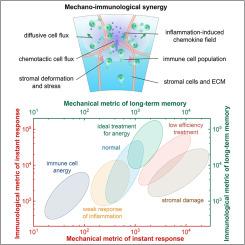炎症和体内平衡期间淋巴结重塑的机械免疫框架
IF 6
2区 工程技术
Q2 MATERIALS SCIENCE, MULTIDISCIPLINARY
引用次数: 0
摘要
在免疫应答过程中,淋巴结(LNs)在其几何结构、细胞组成和力学性能方面经历了显著的耦合演化。免疫反应(IR)的效率是由内部细胞活动和整个炎症稳态过程中的机械变形之间的相互作用决定的。虽然已知机械力在LN重塑中起着至关重要的作用,但LN中机械免疫协同作用的潜在机制仍然知之甚少。在本文中,我们提出了一种机械免疫学理论,该理论将LN定义为IR过程中集成的、动态演变的结构,并建立了一个机械免疫学景观来量化不同的LN状态。该框架引入了一种基于机械-化学-生物机制衍生的指标来评估红外效率的新范式。我们确定了优化IR效率的机械特性范围,并提出肿瘤引流LNs中的免疫衰竭是由机械损伤引起的,导致免疫无能状态。利用提出的机械免疫学方法,我们证明了这种无能状态可以通过调节集体免疫细胞迁移来减轻,以符合最佳IR效率范围,从而提供潜在的治疗策略来提高IR效率。本文章由计算机程序翻译,如有差异,请以英文原文为准。

A mechano-immunological framework for lymph node remodeling during inflammation and homeostasis
During the immune response, lymph nodes (LNs) undergo significant coupled evolutions in their geometric structures, cellular compositions, and mechanical properties. The efficiency of the immune response (IR) is governed by the interplay between internal cellular activity and mechanical deformation throughout the inflammation–homeostasis process. While mechanical forces are known to play a crucial role in LN remodeling, the underlying mechanisms of mechano-immunology synergy within LNs remain poorly understood. In this paper, we propose a mechano-immunology theory that conceptualizes LNs as integrated, dynamically evolving structures during IR and establish a mechano-immunological landscape to quantify distinct LN states. This framework introduces a novel paradigm for evaluating IR efficiency based on metrics derived from mechano-chemo-biological mechanisms. We identify the range of mechanical properties that optimize IR efficiency and propose that immune exhaustion in tumor-draining LNs arises from mechanical damage, leading to an immune anergic state. Using the proposed mechano-immunological methodology, we demonstrate that this anergic state can be mitigated by modulating collective immune cell migration to align with the optimal IR efficiency range, thereby offering potential therapeutic strategies to enhance IR efficiency.
求助全文
通过发布文献求助,成功后即可免费获取论文全文。
去求助
来源期刊
CiteScore
9.80
自引率
9.40%
发文量
276
审稿时长
52 days
期刊介绍:
The aim of Journal of The Mechanics and Physics of Solids is to publish research of the highest quality and of lasting significance on the mechanics of solids. The scope is broad, from fundamental concepts in mechanics to the analysis of novel phenomena and applications. Solids are interpreted broadly to include both hard and soft materials as well as natural and synthetic structures. The approach can be theoretical, experimental or computational.This research activity sits within engineering science and the allied areas of applied mathematics, materials science, bio-mechanics, applied physics, and geophysics.
The Journal was founded in 1952 by Rodney Hill, who was its Editor-in-Chief until 1968. The topics of interest to the Journal evolve with developments in the subject but its basic ethos remains the same: to publish research of the highest quality relating to the mechanics of solids. Thus, emphasis is placed on the development of fundamental concepts of mechanics and novel applications of these concepts based on theoretical, experimental or computational approaches, drawing upon the various branches of engineering science and the allied areas within applied mathematics, materials science, structural engineering, applied physics, and geophysics.
The main purpose of the Journal is to foster scientific understanding of the processes of deformation and mechanical failure of all solid materials, both technological and natural, and the connections between these processes and their underlying physical mechanisms. In this sense, the content of the Journal should reflect the current state of the discipline in analysis, experimental observation, and numerical simulation. In the interest of achieving this goal, authors are encouraged to consider the significance of their contributions for the field of mechanics and the implications of their results, in addition to describing the details of their work.

 求助内容:
求助内容: 应助结果提醒方式:
应助结果提醒方式:


